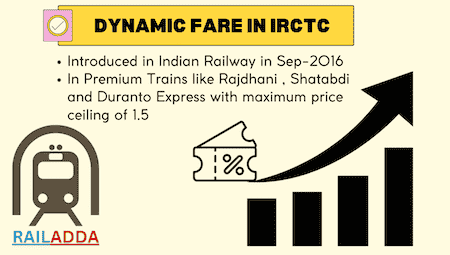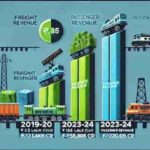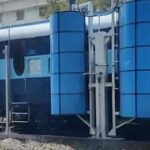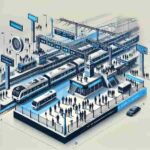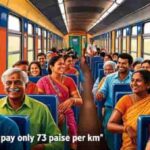What is Dynamic Fare
D(caps)ynamic fare pricing is a business tools aimed to optimize revenue generation by adjusting ticket prices based on demand and availability, encouraging passengers to travel during off-peak periods and distributing the passenger load more efficiently across different trains and times. The sole objective of this method is to increase occupancy along with maximizing revenues.
In contrast to the conventional fixed fare system, where ticket prices remain steady , dynamic pricing adapts based on factor like seat availability , travel demand and booking lead time. This helps business to reduce losses by selling at low price in situation of low demand.
What is Dynamic Fare in trains-Indian Railway
Dynamic fare pricing also known flexi fare system was introduced in Indian Railways in the year 2016. It was implemented for premium trains like Rajdhani, Shatabdi, and Duronto Express and later on some other trains on specific routes for all class except 1AC and EC (Executive class). Under this policy , the fares of the railway tickets are to increase by 10 percent after every 10 percent of berths or seat being sold.
Why Dynamic Fare in trains- Indian Railway
Dynamic fare in trains is implemented to address the complexities of demand and supply within the railway system. it serves several purposes that contribute to the efficiency , revenue generation and overall functionality of the railways. Below are the main factors driving the implementation of dynamic fare pricing.
- Optimising Revenue
- Balancing Demand
- Encouraging Off-Peak Travel
- Reducing Overcrowding
- Maintaining Service Quality
- Ensuring Economic Viability
- Coping with Fluctuations
How dynamic fare is calculated
Indian Railways has implemented a dynamic fare system where the fare increases based on the number of seats sold. The fare increase is calculated using a formula that takes into account the base fare, the percentage of tickets sold, and a maximum price ceiling.
Let’s break down the formula and the example:
- Base Fare:The initial price for a specific ticket classThe fare halts its increase upon reaching the price limit of Rs. 140, regardless of the proportion of seats sold beyond that threshold. is Rs. 100.
- Fare Increase Percentage:Indian Railways has decided that for every 10 percent of seats sold, the fare will increase by 10 percent.
- Price Ceiling:The maximum fare that can be charged is 140 percent (1.4 times) of the base fare.
Here’s a table illustrating the surge price calculation for different percentages of seats sold:
| Percentage of Seats Sold | Percentage of Fare Increase | Surge Price Calculation |
|---|---|---|
| 0% | 0% | Rs. 100 |
| 10% | 10% | Rs. 110 |
| 20% | 10% | Rs. 110 |
| 30% | 20% | Rs. 120 |
| 40% | 20% | Rs. 120 |
| 50% | 30% | Rs. 130 |
| 60% | 30% | Rs. 130 |
| 70% | 40% | Rs. 140 |
| 80% | 40% | Rs. 140 |
| 90% | 40% | Rs. 140 (Ceiling) |
| 100% | 40% | Rs. 140 (Ceiling) |
As the table shows, the fare increases in steps of 10 percent for every 10 percent of seats sold. The fare stops increasing upon reaching the ceiling limit of Rs.140, regardless of the proportion of seats sold beyond that threshold.This is applicable to all class except 1AC and EC.
Other Condition
- Additional charges like reservation charges , Superfast charges , catering charges , service taxes will be imposed separately.
- Vacant seat after charting shall be open for current booking and current booking shall be sold at the last price sold for that class along with supplementary charges as mentioned above shall be levied in full. Tatkal Quota is applicable as per extant guidelines. However no additional charges shall be levied in the name of Tatkal.
- There is no premium Tatkal quota in these trains.
- Normal concession shall be applicable as admissible but only on base fare as shown above.
- Refund is applicable as per extant rules.
How to avoid dynamic pricing in irctc
Avoiding dynamic fare on IRCTC requires careful planning and considering certain strategies to book tickets during times when fares are less likely to be affected by dynamic pricing. Here are few suggestion to assist you in avoiding or to minimise the influence of dynamic fare pricing:
Off-Peak Travel: Choose to travel during off-peak periods, such as weekdays or non-festive seasons. During these times, demand is lower, and dynamic fares are less likely to be high.
Book in Advance: Plan your trip well in advance and book your tickets as soon as the booking window opens. Dynamic fare pricing leave almost nil impact for the tickets booked in advance or on time so proper planning is very much important.
Flexible Dates: If feasible ,consider dates off peak or avoid weekend.Sometimes, shifting your travel date by a day or two can result in lower fares.
Avoid Peak Seasons: Try to avoid booking tickets during peak travel seasons like holidays and festivals. These are times when dynamic fare pricing is more likely to be in effect.
Early Morning or Late-Night Trains: Trains with departure times during early morning or late at night might have lower demand, leading to potentially lower fares.
Alternate Routes: Consider alternate routes that might not be as popular but can still get you to your destination. These routes might have less volatile fare adjustments.
Check Alternate Classes: On occasions, ticket prices for various classes on the same train may be of notable difference. Check if a different class offers a more affordable option.
Monitoring Fare Trends: Observe fare trends for your chosen train and route. Some third-party websites or apps might offer insights into historical fare patterns.
Use Fare Prediction Tools: Some online tools and apps provide fare predictions based on historical data. While not foolproof, they can offer a general idea of fare trends.
Travel Loyalty Programs: Certain loyalty programs or memberships might offer benefits like fare discounts or early booking access, helping you secure lower fares.
Concerns and Criticisms:
Critics of dynamic fare pricing voice concerns over affordability and accessibility for all segments of society. The sudden spikes in fares during peak periods can be prohibitive for budget travellers. Striking a balance between revenue generation and equitable passenger access remains a challenge for IRCTC.
FAQs
Q.Why does dynamic fare pricing exist?
A.Dynamic fare pricing optimizes revenue and seat utilization for Indian Railways by adjusting ticket prices based on demand and availability.
Q.How can I save on train fares using dynamic pricing?
A.Booking during off-peak periods and planning ahead can help you secure lower fares under the dynamic pricing system.
Q.Are sudden fare increases common under dynamic fare pricing?
A.Fare increases are more likely during peak travel times.
Q.Is dynamic fare pricing applicable to all train routes?
A.It is mainly applicable to premium trains, Shatabdi Express, Rajdhani Express, and trains on popular routes.
Q.Can budget travelers benefit from dynamic fare pricing?
A.While dynamic fare pricing aims to balance revenue, its sudden fare increases during peak periods can pose challenges for budget-conscious travelers.
Q.can dynamic fare decrease in irctc?
A.No, it only increase.
